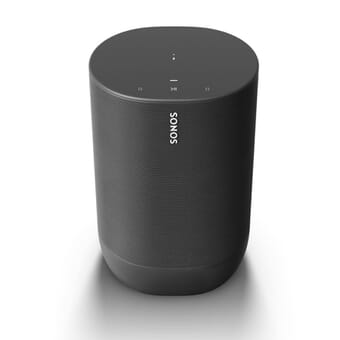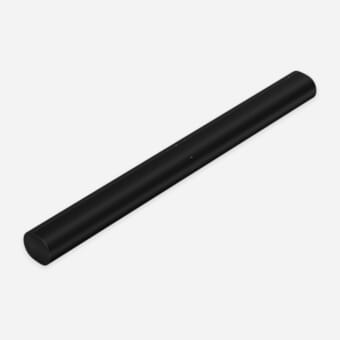Sonos Wireless Speaker & Soundbar Range Overview 2020
Video to text transcription below
Hi guys, it’s Jonathan from Smart Home Sounds. If you’re new to our channel then welcome, I hope you find this video helpful and if you’re a regular then welcome back! We’ve been making videos like these for a while now and thought it was probably time to do a full overview of the Sonos range, especially since the addition of the latest Sonos products.
If you’re fairly new to the world of Sonos then hopefully this video will be a good place to start & give you a better idea of what you might be looking for. I’ll pop timestamps below so you can skip forward to certain products if there is already a speaker you’re interested in.
To give you a quick summary, Sonos is a home audio company specialising in smart, wireless speakers. Founded in America almost 20 years ago in 2001, they have always been a very forward-thinking brand, pushing the limits with the most cutting edge technology.
They’ve come a long way with their products and today we’re going to discuss their range of wireless speakers and soundbars, covering who they are right for and giving you some pros and cons of each product. We hope that by creating videos like this you’ll be in a better position to make a more informed purchase decision and if we’re wrong, we offer a 30 day listen better promise so you’re covered!
In front of me, I’ve got a line-up of Sonos products. I’ve got their 4 wireless speaker options, the Sonos One (Gen 2), One SL, Move and Five. Their two soundbar options, the Sonos Beam and the Sonos Arc and this is their wireless subwoofer, the Sonos Sub. They do also offer a few other products including the Sonos Amp and Port as well as in-ceiling, in-wall and outdoor speakers but we’ll be focussing on these 7 products today and covering those in another video.
Sonos speakers are set up and controlled over WiFi which offers a more reliable connection compared with Bluetooth. For example, your playback won't be interrupted if you get a phone call or watch a video on social media and it also means you’re free to roam around your home without worrying about moving out of range. Instead, the Sonos app is used to stream music from over 100 different streaming services and global radio stations and can also be used to group speakers and control your multi-room setup - I’ll come back to this later on.
All of these speakers also benefit from free software updates via the Sonos app which enables your speakers to get smarter over time as new technologies and updates are released. For example, Airplay 2 and Google Assistant were both added to all Sonos One speakers via a free software update in the Sonos app.
Sonos One (Gen 2)
So, let’s start with the Sonos One (Gen 2). This is their entry-level, wireless smart speaker retailing at £199 RRP. It’s suitable for small to medium-sized rooms such as a bedroom, kitchen and home office. This small speaker is packed with features. It offers built-in voice control with either Amazon Alexa or Google Assistant so you can control playback hands-free.
The One is also compatible with Airplay 2 so you can cast any audio from an iPhone, iPad or Mac device, or if you’re a Spotify user you can use the Spotify app to send your music straight to your Sonos speaker. The Sonos One, like all other Sonos speakers, offers trueplay tuning for enhancing the sound to suit your room but I’ll explain this properly later in the video.
The One (Gen 2) is a sleek, compact speaker available in either Black or White to suit your room decor. It also features a touch control top panel which enables you to play/pause, skip tracks, change the volume or cut the power to the microphones for complete privacy.
The One also offers impressive sound for a speaker of this size with one tweeter for crisp high-frequencies and vocals and one mid-woofer for rich bass and mid-range vocals and these are powered by 2 Class-D amplifiers.
While it does sound great on its own, the One can also be used in a stereo pair with a second Sonos One or One SL for precise stereo separation. You can also use a pair of Ones as rears to the Sonos Beam or Arc to add extra immersion to your content, I'll touch on this again later.
Onto the pros and cons. The One has been awarded 5 stars by What Hifi and was awarded T3’s multiroom speaker of the year and gadget of the year in their 2018 awards. The main pros for us is its compact size, allowing you to place it almost anywhere, its impressive sound quality and built-in voice control. On the other hand, it doesn’t offer Bluetooth control as we mentioned earlier which some may be looking for and it’s also not portable.
Sonos One SL
If we move onto the One SL, you’ll notice it looks almost identical to the One. Essentially it’s the same speaker with the same build, same internals, same sound and pretty much all the same features. The only difference is that the SL doesn’t offer voice control and therefore doesn’t have a mic touch control on the top panel or any built-in microphones. It’s also £20 cheaper than the One with an RRP of £179.
Therefore, this speaker is perfect if you wouldn’t use voice control or are looking for a slightly cheaper alternative. We would recommend a pair of SLs if you are looking to add rears to a Sonos soundbar as both the Beam and the Arc offer voice control so it’s not needed in the rears. You can also pair one Sonos One with one Sonos One SL to be used in a stereo pair or as rears. So for the pros and cons, they’re pretty much the same as those for the One but this time a pro would be the cost and no voice control if that’s something that you’re looking for!
Sonos Move
Moving onto the Sonos Move which sits in the middle of the range in terms of sound quality and price with an RRP of £399. First and foremost, this is a Sonos Wifi speaker for your home but it also offers Bluetooth connectivity and control making it a portable speaker.As you can see it’s not a small portable speaker as this has been designed primarily as a home speaker which you can carry from room to room but also take outside or on a trip with you. With a reliable wifi connection at home and the option to switch to Bluetooth when you’re out of range, the Move offers the best of both worlds. At £399, it’s not a cheap speaker however it offers incredible sound and a number of great features.
Firstly, like the One, the Move offers both Amazon Alexa and Google Assistant voice control for hands-free control of your speaker and 6 far-field microphones ensure you can be heard even when it’s noisy. It is also compatible with Airplay 2 and Spotify connect, offering a range of control options.
The Move comes supplied with a charging base where it can sit in your home as a dock but it also has a built-in rechargeable battery which offers around 11 hours of battery so you can enjoy your music on the go.
Design-wise, the Move is a pretty durable speaker with a drop-proof design and an IP56 weatherproof rating which means it’s fully resistant to rain, extreme temperatures etc. Available in either black or Lunar white, the Move has a metal grille and a rubberised, non-slip bass, as well as a carry, handle and touch controls on the top panel.
We have done a full in-depth review of the Move which I’ll link below and we really put it to the test dropping it from a height and taking it out in pretty heavy rain, testing the battery and recharge and it passed all of our tests.
Inside, the Move boasts 2 class d digital amplifiers, one mid-woofer and one downward firing tweeter which come together to offer a balanced, smooth sound with deep, rich bass. The Move differs from other Sonos speakers where instead of manual trueplay tuning, it offers automatic trueplay tuning. This ensures the Move is acoustically optimised whether you’re indoors or outdoors.
For the pros and cons, on one hand, we love its durable design, the fact it offers both Bluetooth and WiFi connectivity, the long-lasting battery life (and that it is quick to recharge) and the addition of voice control.
However, there are definitely cheaper portable speakers on the market and there are a few things we would change like you can’t use the Sonos app to control music when connected via Bluetooth and you, therefore, can’t check the battery percentage unless connected to wifi.
Sonos Five
Ok, let’s move onto the biggest and boldest wireless speaker, the Sonos Five which has an RRP of £499. This is the third generation of Sonos’s largest speaker in the range following on from the Sonos Play:5 Gen 1 and Gen 2. The Five is the obvious choice for true music lovers, offering studio-quality, room-filling sound for even the largest spaces. Like the Sonos One, you can use it as a standalone speaker, in a stereo pair or as rears to a soundbar which would be a pretty serious setup!
The Five offers a sleek appearance available in an all-white or all-black design to suit your decor. It has touch controls on the top panel, a perforated grilled and little rubber feet on 3 of the sides. This is because the Five can be placed in 2 orientations, horizontal or vertical and it will automatically adjust the acoustics for whichever orientation you choose.
As i mentioned earlier, the Five offers the best sound experience out of these 4 speakers. With 3 woofers for deep, rich bass and a trio of tweeters for vocal clarity and impressive detail all packed into a sealed architecture to eliminate reverb and echo. The left and right tweeters are positioned outwards in a phased speaker array to offer a wider soundstage to fill a room comfortably.
The Five also has a 3.5mm line-in jack for connecting a turntable or CD player. This offers a great partnership with traditional HiFi sound enjoyed with the latest technology in the Five. One thing we love is that the Five can automatically detect when the audio starts playing from an external device so you’ll hear the distinct crackle as soon as the needle hits the record. The great thing about the Sonos ecosystem is you can then send this audio to any other Sonos speakers in your system via the Sonos app to enjoy the sound of your vinyl records anywhere in your home.
Unlike the Move and One, the Five doesn’t offer built-in voice control which will be disappointing for some. There is, however, a workaround as you can connect a smart device such as an Amazon Echo to access voice control on the Five. It does still offer Airplay 2 and Spotify connect for other control options.
This model also offers updated internals including future-ready computing hardware, increased memory and processing power and BLE (Bluetooth low energy), NFC (near field communication) and an updated wireless radio.
The main pros for the Five are vibrant, room-filling sound, a sleek design, updated internals and that line-in option for simple connection to a turntable. On the other hand, there’s no built-in voice control, you can’t stereo pair a Sonos Five with the older generation of Play:5 speakers, there’s no support for Bluetooth and that line-in connection is disabled if you decide to use the speakers as rears to a soundbar. Again, we did a full in-depth review of the Five on our YouTube channel so check that out in the description if you’re interested.
Ok, so that covers the 4 wireless speakers in the range. Let’s move onto the 2 options you have when looking for a Sonos soundbar for your TV. I’ll just point out that while their main usage is for TV audio, they are also designed to play music and can be used as part of your whole-home sound system in that regard.
Sonos Beam
The first option is the Sonos Beam. Retailing at £399 RRP this is their more affordable option and is suitable for small to medium-sized rooms. The Beam is a compact, smart soundbar which will take all of your content, whether it’s films, music, gaming, or TV shows, to the next level. It’s a great way of experiencing cinematic sound in your living room at an affordable price point.
The sound performance is pretty impressive from the Beam. With 4 full-range drivers and a tweeter, the Beam is particularly notable for its crystal clear sound and attention to detail. Despite its compact size, it is also able to produce a wide soundstage, pushing the sound wider and further. It also offers 3 passive radiators which supercharge the bass to ensure you feel every explosion and engine rev in your favourite movies and TV shows.
A nice feature on both Sonos soundbars is night mode and speech enhancement. Night mode is great if you’re watching a film late at night as it suppresses the louder more bassy sounds so you don’t wake up the kids! Speech enhancement goes hand in hand as it brings out the vocal sound channel, ensuring you don’t miss anything when the volume is turned down. The beam also offers voice control with Amazon Alexa or Google Assistant, Airplay 2 and Spotify connect.
Many customers choose to start with the Beam on its own to enhance the TV audio however the great thing about Sonos is you can grow this to a wireless 5.1 system by adding a sub and rears - this can be done gradually over time as well.
The Beam has picked up multiple awards including the T3 awards for best soundbar under £500 and Best TV audio Product as well as the What HiFi award for Best soundbar in the £300-£500 category in 2019. For us, the Beam is probably our favourite Sonos product in terms of value for money when it comes to performance and versatility. It offers a simple connection via HDMI ARC, a compact design to suit any room, impressive sound for your TV, voice control and can be built on to create a 5.1 surround sound setup.
On the other hand, it doesn’t offer support for Dolby DTS or Atmos and while you can connect a Sonos subwoofer, you can’t connect a non-Sonos subwoofer to boost the bass.
Sonos Arc
The second option you have for a Sonos soundbar is the Sonos Arc. This replaced the much loved Sonos Playbar in 2020 and is Sonos’ premium soundbar. Best suited for larger rooms, the Arc offers support for Dolby Atmos for a superior sound experience when watching Dolby Atmos content. Dolby Atmos is a 3D object-based sound format that allows you to experience movies, TV & games with precise immersive sound.
The Arc has upward-firing drivers which create a multi-dimensional soundstage that moves around you, rendering every vocal & explosion with dramatic clarity, detail and depth. I won’t go into more depth than that in this video but if you want to learn more about that, check out our in-depth review of the Arc for everything you need to know again I’ll pop a link below.
As you can see, the Arc is considerably longer than the Beam and is suitable for TVs 49 inches or larger. This elongated design offers an ultra-wide soundstage and houses 11 multi-directional custom woofers which surround you in the story and enables you to experience that next level of listening experience full of rich sound and clarity.
Design-wise, although the Arc is a wide soundbar, this 270-degree curved design ensures it doesn’t draw attention away from the screen and it also boasts a sleek mesh grille and these touch control top panels. It is also available in matte white or matte black to suit your room decor.
The Arc offers voice control with Amazon Alexa and Google Assistant and is compatible with Airplay 2 and Spotify connect. Night mode and Speech enhancement is also available on the Arc as well as auto remote syncing for simple control. Like the Beam, the Arc can create a full surround sound setup by wirelessly adding a sub and rears and this would be one hell of a setup, filling the largest rooms with great sound.
There are a lot of pros for the Arc, Dolby atmos support and truly impressive sound being at the top of that list. However, it does come with a £799 price tag which is quite a jump up from the Beam. If you’re torn between the two you should consider the size of your room and TV and whether you have that extra £400 budget to push for that premium sound experience.
Sonos Sub
The final product I have here is the Sonos Sub, their powerful wireless subwoofer which retails at £699 RRP. The Sub can be wirelessly added, with a simple one-button setup, to any Sonos speaker or speakers apart from the Move. It adds vibrant, deep-impact bass to any setup to take your audio to the next level whether it’s movies, TV shows, music, gaming etc.
As you can see, it offers a sleek design and is available in black or white to suit your home. Internally it houses two force-cancelling speakers which are powered by separate Class-D amplifiers and are positioned face-to-face, as you can see here, to eliminate vibrations which mean there’s no rattle or buzz from this sub. You can place it anywhere in your room and even lay it flat under a sofa without impacting the sound experience.
This product offers future-ready computing hardware as well as increased memory and processing power, BLE, NFC and an updated radio. We love how simple it is to add that extra bass, it’s quick and easy to connect, can be placed anywhere and that zero rattles/buzz is something we can really appreciate. However, it does come with a £699 price tag and isn’t compatible with non-Sonos wireless speakers so you need to consider how much you would appreciate that added bass in your music and movies.
So that wraps up these 7 products. As I mentioned, Sonos products can be grouped together to create a variety of different setups. You can opt to have just 1 speaker or a number of different speakers in different rooms of your home which can be controlled via the Sonos app and either play different music in different rooms or the same thing throughout your home.
You can also create stereo pairs with 2 x One or One SL speakers or 2 x Sonos Fives. Finally, you can create a home cinema setup using either the beam or arc with the sub and 2 rears for an immersive surround sound experience. One of the best things about Sonos for us is that you can grow your setup over time. You can start with just 1 speaker and add more as and when you want or can afford it.
All Sonos speakers offer Trueplay tuning which acoustically optimises the speakers for the space they are in. Using the Sonos app on an IOS device, Trueplay detects the size and layout of your room and the furniture in it and then tweaks the EQ settings for the best acoustic performance possible in that space. This is a feature we love on Sonos speakers as it ensures you’ll be getting the best sound for your room.
We have done full in-depth reviews of all the speakers we have discussed in this video so I’ll pop links to all of those in the description if you want to delve a bit deeper. If you have any other questions or want any specific advice for your home and setup then do get in touch. Drop us an email, give us a call or use the live chat on our website, our customer service team are always more than happy to help.
I hope you found this video helpful if you did then give us a like and subscribe and leave us a comment and let us know what other videos you’d like us to do next! Thanks for watching, I’ll see you next time.





